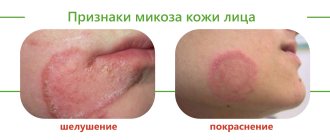Human papillomavirus infection today is the most common disease with predominant sexual transmission.
The causative agent of the infection is human papillomavirus, abbreviated as HPV.
Young women aged 20-35 years have the greatest risk of contracting HPV.
Although in most cases the infection is asymptomatic and tends to heal on its own, sometimes papillomaviruses cause serious conditions.
Such as anogenital warts and cervical cancer (93% of all episodes of the latter disease are associated with HPV, of which 70% are provoked by HPV types 16 and 18).
Of particular interest to women of reproductive age is the answer to the question: does HPV affect pregnancy?
The fact is that during pregnancy, changes in the hormonal background and immune system of the body contribute to the “retention” of HPV, increasing the risk of a woman becoming infected and transmitting the virus to her partner.
In addition, any infection in the mother's body can affect the health of the unborn child.
What is HPV infection?
A specific feature of HPV is its tendency to infect epithelial cells of the skin and mucous membranes.
Several dozen known types of human papillomaviruses are grouped into three groups according to their ability to provoke cancer.
In this case, they distinguish:
- non-oncogenic, examples of which are types 1,2,28, 41, etc., responsible for the appearance of skin warts (plantar, vulgar, etc.);
- with a low risk of developing oncopathology, such as types 6,11, 15, 25, 43, etc., infection with which can manifest itself in the form of anogenital warts (otherwise genital warts) and be accompanied by the development of malignant transformations only in extremely rare cases;
- with high risk, including types 16, 18, 33, 52, etc., infection with which is associated with precancerous/cancerous changes in the cervix, as well as a disease such as bowenoid papulosis.
How does HPV infection occur?
Papillomaviruses can only be transmitted from person to person.
Since some types can persist for a certain time in exfoliating skin cells, they may pose a risk of household contact infection.
This option is typical for the non-oncogenic group; for example, infection with the formation of plantar warts is likely in the presence of microdamages to the skin of the feet.
Low- and high-oncogenic viruses are transmitted sexually, including various types of sexual contact.
Infection of newborn children by sick mothers occurs occasionally.
Interestingly, women with diabetes, when their glucose levels are well controlled, do not have an increased risk of HPV infection.
The incubation period is quite long and can vary from three months to several years.
Own results
We conducted a study that included 287 men with chronic prostatitis/chronic pelvic pain syndrome IIIA, 23 of whom had infertility. Diagnoses were verified according to the criteria of the European Urological Association [30].
In addition to standard diagnostic procedures, HHV types 4–6 were detected in samples from the urethra, prostate secretion, and ejaculate.
When HHV was detected, patients with infertility (group 1) were prescribed valacyclovir 1000 mg/day for 3 months. and the drug VIFERON® (interferon α-2b in combination with antioxidants (vitamins E and C)) in the form of rectal suppositories. Based on the authors’ personal experience, patients were prescribed the following regimen of drug use: 3 million IU 2 times a day for 10 days, then 3 times a week (also 2 times a day) for the next 3 weeks. Viral load was monitored at the end of 3 months of treatment. The remaining patients in whom HHV types 4–6 were not detected (group II) were prescribed levofloxacin 500 mg for 30 days, tamsulosin 0.4 mg for 3 months, diclofenac suppositories 50 mg for 10 days.
In addition to the acyclic nucleoside, which has a direct antiherpetic effect and is prescribed for the treatment of abacterial prostatitis associated with herpes viruses, VIFERON® was chosen as a drug that can provide a long-term antiviral effect. The drug contains interferon α-2b, which is a human recombinant analogue of a substance produced in any cells of the body. It has antiviral, immunomodulatory, antiproliferative properties, suppresses the replication of RNA and DNA viruses. Interferon α-2b in cells triggers a sequence of reactions leading to suppression of the synthesis of viral proteins, assembly and release of virions into the intercellular matrix. In addition to influencing protein synthesis, interferons have epigenetic activity, activating hundreds of genes that play an important role in the antiviral defense of the cell [31]. In addition, interferon α-2b limits the spread of viral particles by activating the so-called “genome guard” protein p53, which leads to apoptotic death of the infected cell [32]. Ascorbic acid and α-tocopherol acetate, which are part of the drug, are highly active antioxidants, have anti-inflammatory, membrane stabilizing, and regenerating properties.
In 11 patients with identified herpes viruses, electron microscopic examination of sperm was performed (JEM 1400, JEOL, Japan).
We noted that out of 103 patients with detected HHV types 4–6, 8 had infertility (group I), while among 184 patients without herpes viruses, infertility was verified in 15 (group II).
Of the 24 urogenital samples from 8 patients in group I, 12 virus-positive samples were obtained: 7 - ejaculate, 1 - urethral smears, 4 - prostate secretions. CMV and EBV were detected in 4 and 3 samples, respectively, including samples with combinations of 2 HHVs. HHV-6 was much more common - in a total of 7 samples out of all 12. The median viral load of herpes viruses types 4–6 was 1770 copies per 100,000 cells.
As a result of antiviral treatment, by the end of the 3rd month, control studies detected the virus in only 5 of 8 patients in group I, in whom herpes viruses were detected in 5 bioassays. At the same time, the median viral load in them decreased to 48 copies per 100,000 cells.
As a result of therapy for 6 months. after the end of treatment, pregnancy was observed in the spouses of 10 out of 23 men, who were distributed into groups as follows: 6 out of 8 from group I and 4 out of 10 from group II. Statistical analysis showed that differences in pregnancy rates reached significant significance between groups I and II (χ2 criterion value was 4.960, critical χ2 value at the significance level p=0.05 was 3.841, significance level p=0.026).
The effect of the course of antiviral therapy was also assessed by electron microscopy. A study of spermatozoa of 11 patients with infertility showed that if before treatment, HHV capsids of types 4–6 were found in 8 patients, then after treatment in 4 of these patients, viral capsids were no longer detected in spermatozoa, and in 3 other patients the number of spermatozoa with capsids was on average decreased by more than 2 times: from 12% to 5% of infected gametes in the ejaculate (Fig. 1).
How does the infection manifest?
Symptoms of infection are determined by the type of virus and the type of illness it causes.
HPV can be located either outside the cell chromosomes, the so-called. benign form of the disease, and integrated into DNA, the malignant form.
The following development options are typical for human papillomavirus infection:
- latent course - without cell changes, without symptoms;
- the formation of warts, condylomas, papillomas, when the virus affects cells, provoking their growth;
- neoplastic changes (dysplasia) – changes in cellular structure under the influence of a virus;
- carcinoma formation - the appearance of numerous atypical cells characteristic of a cancerous tumor.
An important feature of HPV infection is its ability to self-heal.
In 90% of all episodes of infection, the virus is destroyed by the body within two years.
Clinical manifestations of infection are quite characteristic.
Thus, vulgar warts look like grayish-brown warty nodules, which are usually located on the fingers and the back of the hands.
Flat warts affect the face and hands and usually appear during adolescence.
Plantar warts appear in areas where the skin rubs against shoes and are characteristic thickenings that are painful when pressed.
Genital warts are shaped like a rooster's comb or a cauliflower stalk, have a thin stalk and a wider head.
In women, such formations are usually located at the entrance to the vagina, in the area of the labia and anus. Multiple flat papules, as a manifestation of infection caused by HPV of low oncogenic risk, are called epidermodysplasia verruciformis.
With laryngeal papillomatosis, typical growths are detected in the larynx.
Dome-shaped and flat, smooth, velvety papules on the genitals are a characteristic manifestation of bowenoid papulosis.
The cause of which is predominantly HPV-16 (a representative of the high oncogenic risk group).
Malignancy of such formations is observed in approximately 3% of episodes.
Dysplasia (neoplasia) of the cervix is a process of atypical changes in epithelial cells in the zone of transition of squamous epithelium to columnar epithelium.
This condition is considered precancerous.
Depending on the severity of cell changes, different degrees of dysplasia and cancer itself (squamous cell carcinoma) are distinguished.
Promote the development of dysplasia:
- multiple pregnancies and births before the age of 20;
- early onset of sexual activity;
- promiscuity;
- chronic inflammation of the uterine cervix;
- damage by genital warts;
- smoking, etc.
What are the consequences of HPV during pregnancy?
To date, there is no reliable evidence of a pronounced negative impact of infection on the course of pregnancy.
Pregnancy pathologies such as miscarriage, premature birth, etc., which are characteristic of other sexually transmitted infections, have not found unconditional confirmation of the connection with HPV.
However, if a woman’s primary infection occurs during pregnancy, there is a risk of developing various complications.
Anogenital warts in the mother caused by HPV types 6 and 11, localized in the area of the labia minora and the vestibule of the vagina, have some consequences for the fetus during pregnancy.
Such genital warts carry a small risk of infection of the fetus during childbirth, leading to the development of respiratory papillomatosis in the latter.
Respiratory, or otherwise laryngeal, papillomatosis (also called laryngeal papillomatosis) most often develops in children 2 to 3 years old.
As a result of infection from a sick mother during the latter’s pregnancy or immediately at birth.
The route of transmission during pregnancy through the placenta, during childbirth or immediately after it is not yet entirely clear.
The main symptoms of the disease are hoarseness, up to the complete disappearance of the voice, and difficulty swallowing.
As the disease progresses, shortness of breath and cough appear.
In severe situations, blockage of the upper respiratory tract and asphyxia are possible, especially in the case of formations with a long thin stalk.
During examination using a laryngoscope (sometimes a bronchoscope is also used), typical growths - condylomas - are found on the laryngeal mucosa.
This pathology has a rather aggressive course: after removal of the formations, relapses often occur, requiring repeated surgical interventions.
If pregnancy occurs due to infection with highly oncogenic papillomaviruses (especially HPV 16, 18), the woman must inform her obstetrician-gynecologist about the presence of infection.
The fact is that changes in a pregnant woman’s body can provoke more intense cell transformation.
Actually, such viruses do not affect the course of pregnancy itself or the child, but they pose a certain threat to the woman’s health.
In a situation where no infection was detected in the past, a cytological Papanicolaou smear (Pap test) is taken, among others, when registering.
If the analysis shows abnormalities, the doctor prescribes additional tests (for example, colposcopy).
Also, situations when pregnancy occurs in women with erosion require special attention.
PCR diagnostics are required to exclude infection with high-oncogenic risk HPV.
As a rule, in the routine practice of an obstetrician-gynecologist, such a combination as HPV and pregnancy is not specifically examined.
Tests for the virus are recommended only if pathological abnormalities are detected.
At the same time, there are research studies demonstrating the effect of the virus on pregnancy.
Thus, it has been shown that infection of women with HPV slightly reduces the likelihood of embryo implantation, and in men it reduces sperm motility.
And since in a married couple, as a rule, both partners are infected, the onset of pregnancy is associated with some difficulties.
As a result, when planning a pregnancy against the background of an infection caused by HPV, planning an IVF procedure, this factor should also be taken into account.
Introduction
Infertility is a pressing medical and social problem.
In Russia, every fifth married couple is infertile [1]. Moreover, the male factor is responsible for half of these cases. This is associated with a progressive decline in reproductive function. There is numerous data on the negative impact of viruses on the state of the male reproductive system. Human herpes viruses (HHV) are widespread in the human population [2]. Herpes viruses cause lifelong infection and are the cause of many diseases, half of which have a relapsing course. From 95% to 100% of the population are infected with HHV, and at different periods of life a person is infected with at least one, and more often, several types of viruses belonging to the herpesvirus family. In the second half of life, almost all people have antibodies to most HHVs [3]. 8 types of herpes viruses are pathogenic for humans.
How is HPV diagnosed in pregnant women?
First of all, the diagnosis of infection begins with a clinical examination.
Genital warts, like other types of formations, are easily identified by their appearance.
If condylomas are present, examination of the cervix is also required.
In most cases, HPV infection is diagnosed on the basis of a Pap test, which is the primary screening for precancerous changes and cervical cancer caused by the virus.
Papanicolaou cytological examination is a variant of microscopic examination using various groups of dyes.
There are characteristic signs of cell changes detected in this study that support infection with the papilloma virus.
These signs include:
- koilocytosis - a change in the shape and color of the nucleus, an increase in the number of nuclei, the appearance of vacuoles in the cell;
- the appearance of dyskeracites - small cells with colored nuclei and altered cytoplasm.
Another test for HPV during pregnancy is papillomavirus typing using the polymerase chain reaction (PCR).
However, due to its high sensitivity, such a study often leads to overdiagnosis of diseases, since in most cases the infection is short-term.
This method is important when HPV is detected against the background of a characteristic clinical picture.
As a result, global medical guidelines do not recommend the use of PCR as a prognostic test in women under 30 years of age.
At an older age, such a study, especially in the case of determining the group affiliation of the virus, is more significant.
If necessary, additionally resort to instrumental diagnostic methods, such as colposcopy and urethroscopy.
Colposcopy and biopsy with histological examination are performed for all women with neoplasia detected during the Pap test.
During colposcopy, a test with acetic acid and Lugol's solution is also performed.
A colposcopic sign of HPV infection is uneven staining with iodine solution, blanching of areas after treatment with acid.
Diagnostic measures
HPV is transmitted through sexual contact and contact, but the pathogen does not penetrate directly into the blood. Pathogenic microorganisms multiply in the thickness of the skin and mucous membranes, so samples of mucus from the cervical part of the uterus and the urethral canal are taken from patients for research.
- Polymerase chain reaction. This method of identifying papillomaviruses in the body is considered one of the main ones. The most common variants of PCR tests are the detection of pathogens of papillomatosis types 16 and 18 in smears. Samples of biological material for research are taken from the surface of the vagina and from the mucous membrane of the uterine cervix. This diagnostic method is quite popular, as it allows you to determine any strain of HPV, even if the amount of its DNA does not exceed 10 molecules. No less important is the fact that polymerase chain reaction research is inexpensive and can be carried out quite quickly (5-7 hours).
- Screening testing. A completely new diagnostic method that appeared in the medical community not so long ago. In the case of examination for HPV types 18 and 16, this analysis allows us to judge the concentration of the pathogen in the body.
- Cytological analysis. In order to determine the human papillomavirus in women, a smear is taken from the surface of the cervix directly during a gynecological examination. The appearance of transformed, unhealthy cells in the biomaterial indicates the presence of dysplasia.
- Histological method. The study involves the detection of altered cellular structures in histological material. For this purpose, a small tissue sample is taken from patients from a suspicious area of the mucous membrane or skin, which makes it possible to evaluate the structural structure and stage of change of malignant cells.
How is HPV infection treated during pregnancy?
When infected with HPV, pregnancy and childbirth have some specifics.
Thus, in some women with HPV infection, during pregnancy, the manifestations of the disease may increase, such as changes in cervical cells and genital warts.
However, doctors are usually in no hurry to prescribe treatment.
Since the latter can provoke premature birth, in addition, after childbirth, the manifestations of infection may noticeably decrease on their own.
Therefore, it is recommended, if possible, to adhere to expectant management and dynamic monitoring of the pregnant woman.
However, there are situations when genital warts grow noticeably and their number increases.
They merge into giant formations.
Women may experience pain when walking, difficulty defecating and urinating.
During childbirth - traumatization of formations, bleeding, problems with the passage of the fetus through the birth canal, ruptures of the vaginal walls.
In such cases, it is necessary to remove condylomas before delivery.
If the removal of the formations could not be carried out on time, the doctor may decide to deliver the patient by cesarean section.
In routine practice, this measure is not used to prevent fetal infection.
Since there is no reliable data confirming that cesarean section prevents the development of respiratory papillomatosis in children of sick mothers.
If abnormal cell changes were detected during pregnancy, a Pap smear test should be repeated a few weeks after birth.
Often, after childbirth, both genital warts and cellular changes disappear on their own.
Accordingly, treatment of such conditions is not required.
In other situations, certain therapeutic procedures are carried out.
In pregnant women, removal of condylomas can be carried out through cryotherapy, using a carbon dioxide laser, electrocoagulation, or surgitron.
For large, easily traumatic formations, it is recommended to remove them surgically after the first trimester until the 36th week of pregnancy.
The use of drugs such as podophyllin, 5-fluorouracil, as well as the use of intralesional interferon is not allowed during pregnancy.
Little dirty tricks, or what papillomas are silent about
The head of the gynecological department of the Nuriev Clinic, Nelly Mikhailovna Samukova, answers the main questions regarding human papillomavirus infection. What kind of virus is HPV?
HPV - human papillomavirus (also known as PVI - human papillomavirus infection and HPV - Human Papillomavirus) is the cause of condylomas and genital warts and a frequent “precursor” of cancer. HPV transmission can occur through intimate intimacy, even without actual sexual intercourse. The virus can also be transmitted through household contact: through contact with contaminated personal hygiene products (through towels, washcloths, a shared bath or toilet). This infection has no specific symptoms. Many people do not even know that they are carriers of the virus until papillomas begin to cause inconvenience.
Do I need to get rid of papillomas?
I recommend that my patients get rid of external manifestations of HPV before a planned pregnancy or in cases where papillomas or condylomas cause physical and psychological discomfort. There are many methods of disposal: surgical destruction, cryodestruction, electrocoagulation, radio wave exposure. However, after the procedure, the person remains a carrier of HPV (only the risk of relapse is reduced).
You need to understand that papillomavirus manifests itself when immunity decreases, and smoking, drinking alcohol, pregnancy and stress are also “accomplices” of HPV. Therefore, we, doctors, strongly recommend that patients who carry HPV take responsibility for their health. And regardless of your length of sexual activity, visit your doctor regularly. Women should be checked by a gynecologist at least once a year!
How to protect yourself from HPV?
The most reliable protection against the virus is timely vaccination. The course consists of 3 injections into the shoulder muscle: the first is done on the day of treatment, the second – 2 months later, the third – 6 months after the first vaccination. Already after the second stage of vaccination, a person develops a fairly stable immunity to HPV. There is no other cure for HPV.
HPV vaccination should be carried out before sexual debut. Optimally – at 9-26 years old. Before vaccination, you need to be tested for HPV carriage. I will add that if HPV types 6, 11, 16 or 18 are detected, vaccination is useless. This is a waste of money, no matter how much you are convinced otherwise!
Is it dangerous to get pregnant if you have HPV?
HPV does not affect the course of pregnancy, but there is a slight risk of transmission of the virus from mother to child as it passes through the birth canal and the development of respiratory papillomatosis or condylomatosis of the larynx and respiratory tract.
There are about 300 types of HPV, and 15 of them can cause changes in cells in the lining of the cervix that can then develop into cancer. Therefore, at the Nuriev Clinic, we especially closely monitor expectant mothers in the “Pregnancy Management Program” if they are already carriers of HPV.
If infection has occurred, then there are 3 options for the development of events: either the virus is eliminated (it goes away without a trace), or it lies dormant, waiting for an opportune moment for relapse (decline of immunity), or it develops rapidly (this is indicated by clinical manifestations such as the growth of papillomas and rapid increase in their number). In the latter case, we have a risk of cancer complications. Therefore, I recommend that all women, regardless of their viral status, regularly undergo a smear test for oncology and undergo colposcopy - an examination of the uterus. The second most common cancer (after breast cancer) in women is cervical cancer. Every day in Russia 17 women die from it.
Is HPV dangerous for men?
HPV does not directly affect male potency. However, in some cases, the consequences of this infection in men can be severe: cancer of the penis, rectum, anal canal and perineum. I recommend that representatives of the stronger sex monitor any deviations from the norm on the skin of the penis, on the scrotum and around the anus. And consult a doctor if any changes are detected on the skin, even if they do not hurt.
Remember: you can become infected not only from a sexual partner, but also in everyday life. Neither a condom, nor the virginity of the partner, nor the presence of a permanent sexual partner, nor abstinence guarantees 100% protection against HPV!










